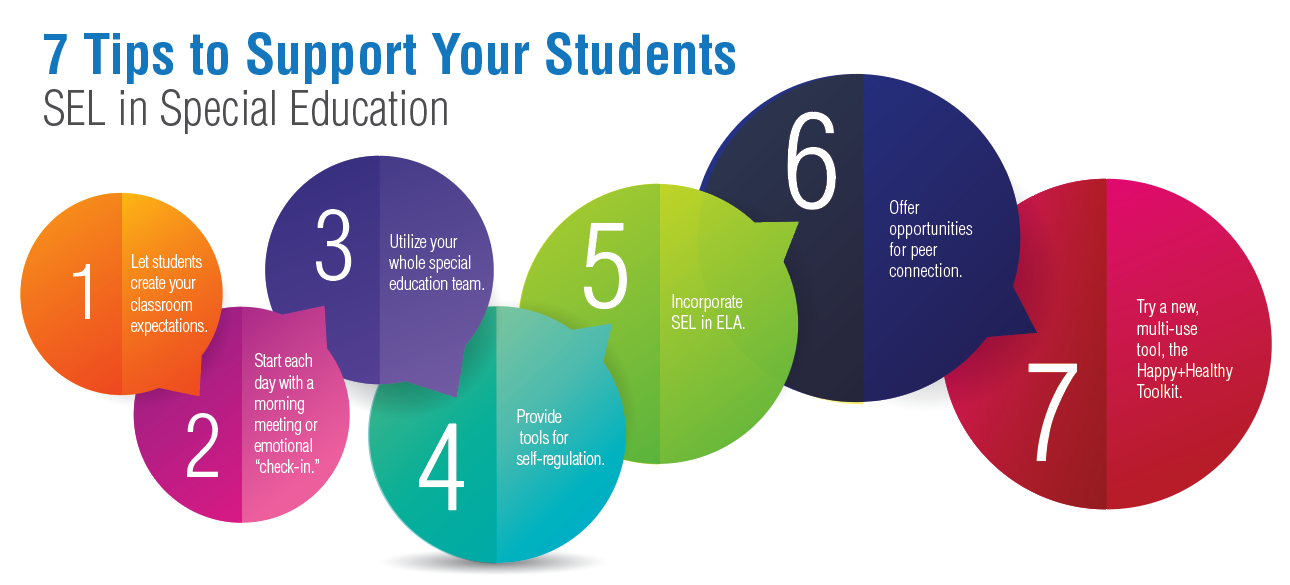
In the second installment of our Social Emotional Learning (SEL) series, we explored student-created classroom expectations and SEL check-ins for students in special education. In this final part of the series we discuss utilizing your special education team, providing tools for self-regulation, incorporating SEL in ELA, offering opportunities for peer connection, and utilizing a new SEL tool. Try implementing one or multiple of these ideas to help respond to student SEL needs now, even during remote or hybrid learning!
3. Utilize your whole special education team.
One of the best parts of special education is that we do not work alone—we have a whole team. I was able to make SEL a consistent, routine part of my last classroom’s weekly schedule with the help of the school social worker, who came to my class once a week and did a SEL mini-lesson with students. This helped me in many ways. First, it made SEL an ongoing part of our classroom and students expected the lesson each week. Second, it was exciting for students to have a new person in the classroom and to be taught by someone other than myself. Third, I was able to participate in the lessons and model SEL competencies. It also helped that my school social worker had fun lessons and activities, so students felt like it was a break from academic work. The school psychologist was also helpful and did mini lessons on executive functioning for our students. Last, I have had the pleasure of working with multiple amazing paraprofessionals who were able to help students with self-regulation, could run small group social skills lessons, and checked in with students. Use your team! Even remotely, the school social worker or psychologist could help with mini-lessons via video conferencing and paraprofessionals could host breakout groups, help you with Google forms, or help find online self-regulation tools.
4. Provide tools for self-regulation.
[back to top]Every special education classroom needs a space for students to work on self-awareness, self-management, and responsible decision-making. In my classrooms, I have called mine the “Comfy Corner.” In my physical space, I had beanbag chairs and tools for self-regulation, plus a desk away from others. Tools that I liked to have available for students included:
- DIY sensory bottles
- Movement or yoga task cards. This website has many links to free movement activities.
- Social stories, like these free stories about many topics. I also like to use Boardmaker.
- Choice boards for activities to deescalate emotions, such as this example you can download.
- Coloring pages (Yes, even for older students!)
- Small sensory items like fidgets—there are tons on Amazon.
- Visuals I created based on individual student needs
- Different SEL worksheets (very popular with my high school students). Here is an example of one I have used with many students about worrying.
- Sound-blocking headphones
- Task cards with mindfulness tasks such as breathing exercises
Make sure to provide clear expectations for using the tools both in-person and remotely. While the tools above were for in-person teaching, many can be adapted to a remote environment by providing links in a SEL section on your LMS and teaching students and parents or guardians how to use the resources. Here is a digital calm corner that has many activities to help regulate emotions as well.
5. Incorporate SEL in ELA.
One of the easiest ways to incorporate SEL is during English or Language Arts class. Discussions about books, novels, plays, short stories, and news articles are ways to make SEL relevant for students. Examine if character choices are examples of responsible decision-making, or have students discuss what their choice would be. A favorite of mine for discussing responsible decision-making is Romeo and Juliet; students loved to talk about all the terrible decisions characters made and rewrite the play with their own endings based on responsible decisions. Character analysis can help students understand traits about themselves (self-awareness); they can compare and contrast themselves to characters. Students can also analyze social interactions in literature and discuss if characters have good relationship skills or what they would do differently.
Educators can choose literature that correlates with SEL skills they would like to teach. For younger students, there is a multitude of books you can use to teach SEL—here is a great list from the School Library Journal. Here is another booklist with clear age guidelines from the Center on the Social and Emotional Foundations for Early Learning at Vanderbilt. My daughter and I personally love Giraffes Can’t Dance by Giles Andreae, which is wonderful for self-awareness.
Writing activities are also useful for incorporating SEL. Journal writing is a good activity because it is easily adaptable for all levels of students and for remote learning. Students with more significant disabilities can do journals with sentence starters and picture communication choices. Another great accommodation is adding a word bank to journaling activities. I do not find it useful to correct grammar and spelling in journals; in my experience it made students more self-conscious about their writing and was not the purpose of the activity. The biggest tip I have for this area is to write back! My students have always appreciated comments on their journals, and it’s a great way to continue talking about SEL topics. Here’s a link to a worthwhile SEL journal you can use during distance learning with your students. While it is not free, I think this is an incredible resource as it has intentional, daily prompts related to the five competencies. If you are looking for free resources, this blog broke down SEL writing prompts into the CASEL categories and this website has many different SEL-related writing prompts, including the topics of personal growth, self-esteem and confidence, and kindness, to name a few.
"Every special education classroom needs a space for students to work on self-awareness, self-management, and responsible decision-making."
6. Offer opportunities for peer connection.
Social awareness and relationship skills are so important for making friends, getting and maintaining jobs, and overall student confidence. While I am sure you are providing ways for students you service to connect with each other, whether it’s through sharing projects, morning meetings, breakout rooms, debates, etc., least restrictive environment in special education also includes contact with peers in general education. If you had a “lunch bunch” program at your school, where general education students ate lunch with students in special education, perhaps try to think of ways to make it virtual. For example, students from general education could be guests at a classroom Zoom lunch.
Unified Champions, part of Special Olympics, is an incredible program that pairs students in both special and general education together for sports, and if your school participates these students may be interested in still meeting online and coming up with fun ideas to do remotely, such as online parties and games.
Conversation cards, or cards with prompts for beginning conversations, are helpful for getting students to talk to each other when they have deficits in expressive language, have social anxiety, or simply struggle to come up with topics to discuss with others. These can be used between special education students or with general education peers. Hint: there are tons of these cards for sale on Teachers Pay Teachers. Another activity is to have students write their own conversation cards and then utilize them with peers. Or, you can create class anchor charts such as “Things to Say in the Fall” and have students give suggestions. Students who are nonverbal can use augmentative communication devices preprogrammed with suggestions to choose from.
Role plays are also a fun way for students to practice social awareness, relationship skills, and responsible decision making because students can get up and act out scenarios. It is easy to create your own scenarios by thinking about actual issues happening in your classroom. For instance, I had a student having a difficult time getting his food in the cafeteria and interacting with the cafeteria staff. My class was happy to role play getting their lunch and interacting with staff, having one person act as a student getting lunch and one person act as a cafeteria worker. The student was not singled out, he was able to learn from his peers, and we no longer had social skills issues in the cafeteria with that particular student.
Games, even traditional board games, are a great way to work on all of these skills as well. Taking turns, problem solving, talking to others respectfully, and dealing with winning and losing, are all skills students need in order to be successful. You can also create SEL-specific games, such as charades where students have to guess each other’s emotions. Here’s a fun list of easy games you can play remotely with students.
7. Try a new, multi-use tool, the Happy+Healthy Toolkit.
A new tool that I am excited about is the Happy+Healthy Toolkit. The goal of the toolkit is to equip children and
teens with a set of skills to help self-regulate. The toolkit was created with emotional resiliency and trauma-informed care in mind, and based on the concept that students cannot learn if they are not self-regulated. It is composed of a deck of 21 fun, bright-colored cards. The cards are broken down in to seven wellness areas and provide prompts for short, research-based SEL activities. For example, one of the cards in the “Relax” category includes a “belly breath” activity to help calm students. What I like most about these cards is that they have multiple uses: they would be an excellent addition to a “calm corner,” easy to use for mini-lessons, or useful for brain breaks during remote learning. Educators can use the cards with whole or small groups, or students can individually choose cards based on need or interest. The toolkit is accessible for a wide range of students, from pre-k to adolescents, comes in English and Spanish, and has clear, easy-to-read directions and prompts which make the cards perfect for many students with reading disabilities. It is rare to find an activity that is useful in multiple different scenarios, is inclusive of all students, and is easy to use remotely for only $25!
While you wait for your school or district to implement a SEL program, these tips can get you started and on the way to improving your students’ SEL skills. This is by no means a comprehensive guide to SEL strategies and resources; I encourage you to continue learning and implementing new SEL ideas throughout the school year. Do you have any tips to share about SEL? Let us know!




